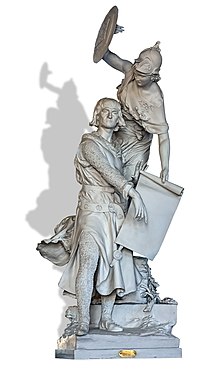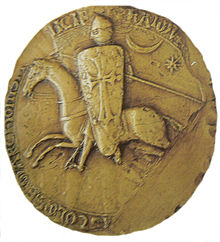|
Raymond VI, Count of Toulouse
 Raymond VI (Occitan: Ramon; 27 October 1156 – 2 August 1222) was Count of Toulouse and Marquis of Provence from 1194 to 1222. He was also Count of Melgueil (as Raymond IV) from 1173 to 1190. Early lifeRaymond was born at Saint-Gilles, Gard, the son of Raymond V and Constance of France.[1] His maternal grandparents were Louis VI of France and his second wife Adélaide de Maurienne. His maternal uncles included Louis VII of France. In 1194 he succeeded his father as count of Toulouse. He immediately re-established peace with both Alfonso II of Aragon and with the Trencavel family. Problems with the ChurchRaymond VI was arguably the first target of the Albigensian crusade (1209–1229).[2] Raymond VI held vast territories but his control of them was problematic. Aside from theoretically owing allegiance to the King of France, Raymond held Provence as a vassal of the Holy Roman Emperor.[3] Henry II of England controlled neighboring Aquitaine through his wife Eleanor of Aquitaine, who had a claim to Toulouse through her grandmother, Philippa of Toulouse, daughter of William IV, Count of Toulouse. Alfonso II of Aragon was involved in the affairs of Languedoc, stimulating emigration from the north to colonize newly reconquered lands in Aragon. In Toulouse, Raymond maintained the communal freedoms, extended exemptions from taxation, and extended his protection to the communal territory. A poet and a man of culture, he hated war but did not lack energy.[citation needed] According to Henri Pirenne, "At the end of the 12th century Languedoc was swarming with those mystics who aspired to lead the Church and the age back to apostolic simplicity, condemning both the religious hierarchy and the social order".[4] At first Innocent III tried to deal with the Cathars by peaceful conversion, sending into the affected regions a number of legates or representatives.[5] Count Raymond declined to assist, although constantly embroiled with his vassals, and given the autonomy of the towns, Kenneth Setton questions whether Raymond "could have coped effectively with the challenge of heresy even if he had wished to do so".[3] The legates sent from Rome and France received little support as they were considered foreign reformers. Papal legate Pierre de Castelnau was sent to address Raymond's tolerance for the practice of the Cathars, but withdrew for six months in 1206 out of concerns for his safety.[citation needed] Pierre's assassination on 15 January 1208, led to Raymond's excommunication.[6] This was followed by the capture and massacre of Béziers, the siege and capture of Carcassonne, and the death of Raymond Roger Trencavel, all in 1209. That same year Raymond had journeyed to Rome in an attempt to reconcile with Pope Innocent III, yet despite his overtures Innocent chose to allow crusade leaders a freehand.[7] In 1211, Raymond's excommunication was reiterated by papal legates, while the Council of Montpellier placed an Interdict over the County of Toulouse.[7] More of a diplomat than a soldier, he was unable to stop the advance of Simon de Montfort, who conquered Toulouse. Following Battle of Muret, Raymond was exiled to England under his former brother-in-law John, King of England.[8] In November 1215, Raymond and his son (the later Raymond VII, Count of Toulouse) were in Rome with Raymond-Roger, Count of Foix on the occasion of the Fourth Lateran Council to vindicate themselves and dispute the loss of their territories. Raymond's son-in-law, Pierre-Bermond II of Sauve, was also there to lay claim to the county of Toulouse, but this claim failed. Raymond and his son went from Rome to Genoa and thence to Marseille in February 1216. Raymond's son set out from Marseille to regain the family territories in Provence; in May 1216 he besieged Beaucaire and captured it on August 24.[citation needed] Meanwhile, Raymond went to Aragon, hoping to rally support. From there he engaged in secret negotiations with leaders in Toulouse during 1216.[9] Simon de Montfort possibly believed that Raymond was on his way to the city in September 1216;[10] at any rate he returned in great haste from Beaucaire and conducted a partial sack of the city, apparently intended as punishment. Finally, on 12 September 1217, Raymond re-entered Toulouse again.[11] Simon de Montfort immediately besieged the city once more. Simon was killed during the siege (25 June 1218);[11] his son Amaury VI of Montfort took his place, and for five years the Crusade faltered. The failure of Louis VIII's campaigns, from 1219 to 1226, finally permitted Raymond, and his son and successor, to recover most of their territories.[12] DeathFollowing an abrupt and unexpected illness that left him mostly speechless, Raymond died in August 1222.[13] But from what was said, he was still able to remember and understand things because he extended his hands in a show of devotion to the Abbot of Saint-Sernin, as soon as the Abbot hurried to his side.[13] He kissed a pall bearing a cross when the Brothers of the Hospital of St. John threw it over him, and then he died unexpectedly.[13] His body was taken to their home, but it was never buried there and is still unburied as of now.[13] In 1998, there was a new twist to this story: during excavations at the Hôtel Saint-Jean in Toulouse, the site of the former Grand Priory of the Knights Hospitaller, a medieval sarcophagus was discovered, and for a moment it was believed that it might contain the bones of Raymond VI. The mayor of Toulouse, Dominique Baudis, took the opportunity to ask the Pope to lift Raymond VI's excommunication, without success.[14] MarriagesRaymond was married six times:
In art Raymond VI is represented as one of four figures on the ceiling of the Minnesota Supreme Court in the United States. His painting is next to Moses, Confucius, and Socrates, each painting representing an aspect of law. Raymond VI's painting is entitled "The Adjustment of Conflicting Interests", and the scene is of Raymond VI of Toulouse standing before the papal legate in 1208. Raymond argued successfully for city freedoms, extended exemptions from taxation, and protection of the communal territory from the church. Not wanting to target his Cathar vassals, he also defended, albeit with less success—since it became one of the causes of the Albigensian Crusade—the idea of religious freedom. The paintings were made by John LaFarge in 1903.[21] In 1889, in a painting exhibited at the Capitole in Toulouse and entitled "Raimond VI Count of Toulouse, the excommunicated 1156-1222", the painter René-Henri Ravaut depicted Raymond VI left at the door of the Church.[citation needed] References
Sources
External linksWikimedia Commons has media related to Raymond VI, Count of Toulouse.
|
||||||||||||||||||||||||||||||

